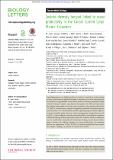Files in this item
Seabird diversity hotspot linked to ocean productivity in the Canary Current Large Marine Ecosystem
Item metadata
| dc.contributor.author | Grecian, W. James | |
| dc.contributor.author | Witt, Matthew J. | |
| dc.contributor.author | Attrill, Martin J. | |
| dc.contributor.author | Bearhop, Stuart | |
| dc.contributor.author | Becker, Peter H. | |
| dc.contributor.author | Egevang, Carsten | |
| dc.contributor.author | Furness, Robert W. | |
| dc.contributor.author | Godley, Brendan J. | |
| dc.contributor.author | González-Solís, Jacob | |
| dc.contributor.author | Grémillet, David | |
| dc.contributor.author | Kopp, Matthias | |
| dc.contributor.author | Lescroël, Amélie | |
| dc.contributor.author | Matthiopoulos, Jason | |
| dc.contributor.author | Patrick, Samantha C. | |
| dc.contributor.author | Peter, Hans-Ulrich | |
| dc.contributor.author | Phillips, Richard A. | |
| dc.contributor.author | Stenhouse, Iain J. | |
| dc.contributor.author | Voltier, Stephen C. | |
| dc.date.accessioned | 2017-05-09T10:30:13Z | |
| dc.date.available | 2017-05-09T10:30:13Z | |
| dc.date.issued | 2016-08-16 | |
| dc.identifier | 249951409 | |
| dc.identifier | 75439630-0326-4ab1-92d6-a585e8d84d71 | |
| dc.identifier | 84983284935 | |
| dc.identifier.citation | Grecian , W J , Witt , M J , Attrill , M J , Bearhop , S , Becker , P H , Egevang , C , Furness , R W , Godley , B J , González-Solís , J , Grémillet , D , Kopp , M , Lescroël , A , Matthiopoulos , J , Patrick , S C , Peter , H-U , Phillips , R A , Stenhouse , I J & Voltier , S C 2016 , ' Seabird diversity hotspot linked to ocean productivity in the Canary Current Large Marine Ecosystem ' , Biology Letters , vol. 12 , no. 8 , 20160024 . https://doi.org/10.1098/rsbl.2016.0024 | en |
| dc.identifier.issn | 1744-9561 | |
| dc.identifier.other | ORCID: /0000-0002-6428-719X/work/32706773 | |
| dc.identifier.uri | https://hdl.handle.net/10023/10727 | |
| dc.description | Funding for this work was provided by the Peninsula Research Institute for Marine Renewable Energy, EU INTERREG project CHARM III, NERC (NE/G001014/1), MINECO CGL2013-42585-P, Defra's Darwin, Centre National de la Recherche Scientifique and Ligue Pour la Protection des Oiseaux within the EUINTERREG Project FAME (2009-1/089; 2010-2012). | en |
| dc.description.abstract | Upwelling regions are highly productive habitats targeted by wide-ranging marine predators and industrial fisheries. In this study, we track the migratory movements of eight seabird species from across the Atlantic; quantify overlap with the Canary Current Large Marine Ecosystem (CCLME) and determine the habitat characteristics that drive this association. Our results indicate the CCLME is a biodiversity hotspot for migratory seabirds; all tracked species and more than 70% of individuals used this upwelling region. Relative species richness peaked in areas where sea surface temperature averaged between 15 and 20°C, and correlated positively with chlorophyll a, revealing the optimum conditions driving bottom-up trophic effects for seabirds. Marine vertebrates are not confined by international boundaries, making conservation challenging. However, by linking diversity to ocean productivity, our research reveals the significance of the CCLME for seabird populations from across the Atlantic, making it a priority for conservation action. | |
| dc.format.extent | 5 | |
| dc.format.extent | 610794 | |
| dc.language.iso | eng | |
| dc.relation.ispartof | Biology Letters | en |
| dc.subject | Biologging | en |
| dc.subject | Human impacts | en |
| dc.subject | Marine protected areas | en |
| dc.subject | Migration | en |
| dc.subject | Upwelling | en |
| dc.subject | Marine conservation | en |
| dc.subject | QH301 Biology | en |
| dc.subject | DAS | en |
| dc.subject | SDG 14 - Life Below Water | en |
| dc.subject.lcc | QH301 | en |
| dc.title | Seabird diversity hotspot linked to ocean productivity in the Canary Current Large Marine Ecosystem | en |
| dc.type | Journal article | en |
| dc.contributor.institution | University of St Andrews. School of Biology | en |
| dc.contributor.institution | University of St Andrews. Sea Mammal Research Unit | en |
| dc.contributor.institution | University of St Andrews. Scottish Oceans Institute | en |
| dc.identifier.doi | https://doi.org/10.1098/rsbl.2016.0024 | |
| dc.description.status | Peer reviewed | en |
| dc.identifier.url | http://eprints.gla.ac.uk/121412/ | en |
This item appears in the following Collection(s)
Items in the St Andrews Research Repository are protected by copyright, with all rights reserved, unless otherwise indicated.

